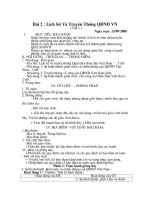- Trang chủ >>
- Khoa Học Tự Nhiên >>
- Vật lý
Physics 2 lecture 2 gauss s law
Bạn đang xem bản rút gọn của tài liệu. Xem và tải ngay bản đầy đủ của tài liệu tại đây (457.88 KB, 30 trang )
Physics 2
Lecture 2
Gauss’s Law
Gauss’s Law
Conductors in Electrostatic Equilibrium
Ngac An Bang, Faculty of Physics, HUS
1
Ngac An Bang, Faculty of Physics, HUS
Gauss’s Law
Gauss’s Law
In a table-top plasma ball, the
colorful lines emanating from the
sphere give evidence of strong
electric fields. Using Gauss’s law, we
show in this chapter that the electric
field surrounding a charged sphere is
identical to that of a point charge.
(Getty Images)
2
Ngac An Bang, Faculty of Physics, HUS
Gauss’s Law
Gauss’s Law
Introduction
A very useful computational technique
Two of Maxwell’s Equations
Gauss’s Law –The Equation
q in
E
EdA
0
Closed surface
The total “flux” of field lines
penetrating any of these surfaces is the
same and depends only on the amount
of charge inside
3
Ngac An Bang, Faculty of Physics, HUS
Gauss’s Law
Gauss’s Law
A An
Introduction
Air flow rate (flux) through A
v A vA
v A vA cos
4
Ngac An Bang, Faculty of Physics, HUS
Gauss’s Law
Gauss’s Law
Electric flux
E E A EA cos 0 0 EA
A An
E E A EA cos EA '
• We showed that the strength of an electric field is proportional to the number of
field lines per area.
• Electric flux ΦE is proportional to the number of electric field lines penetrating
some surface.
5
Ngac An Bang, Faculty of Physics, HUS
Gauss’s Law
Gauss’s Law
Electric flux
In general, a surface S can be curved and
the electric field E may vary over the
surface.
• In order to compute the electric flux, we divide
the surface into a large number of infinitesimal
area elements
Ai Ai ni
• The electric flux through an area element is
E E i Ai E i Ai cos i
• The total flux through the entire surface can be
obtained by summing over all the area elements
E lim E i Ai
Ai 0
i 1
E dA
S
0
6
180 0 90 0 90 0
90
E 0
E 0 E 0
Ngac An Bang, Faculty of Physics, HUS
Gauss’s Law
Gauss’s Law
Electric flux
A rectangle is an open surface —it does NOT contain a volume
A sphere is a closed surface —it DOES contain a volume
We are interested in closed surface
7
Ngac An Bang, Faculty of Physics, HUS
Gauss’s Law
Gauss’s Law
Gauss’s law
For a closed surface the normal vector is chosen
to point in the outward normal direction.
E 0 if E points out
E 0 if E points in
8
Ngac An Bang, Faculty of Physics, HUS
Gauss’s Law
Gauss’s Law
Gauss’s law
E 0 if E points out
E 0 if E points in
9
Ngac An Bang, Faculty of Physics, HUS
Gauss’s Law
Gauss’s Law
Gauss’s law
The net electric flux through any closed surface S is
q in
E
EdA
0
closed surface S
where qin represents the net charge inside the surface
and E represents the electric field at any point on the
surface S.
10
Ngac An Bang, Faculty of Physics, HUS
Gauss’s Law
Gauss’s law
Gauss’s Law
Consider several closed surfaces surrounding a
charge q, as shown in figure above. The number of
field lines through S1 is equal to the number of field
lines through the surfaces S2 and S3 .
E E d A
S1
E dA
S2
q
S E dA 0
3
The number of electric field lines entering the
surface equals the number leaving the surface.
The net flux is zero.
q in
E
EdA
0
0
closed surface S
11
Ngac An Bang, Faculty of Physics, HUS
Gauss’s Law
Gauss’s law
Gauss’s Law
12
Gauss’s Law
Gauss’s Law and Coulomb’s Law
Ngac An Bang, Faculty of Physics, HUS
Around q we have drawn a spherical surface S of
radius r centered at q.
At any point on the surface S, E is parallel to the
vector dA, thus
EdA EdA
Applying Gauss’s law, we have
E E d A
S
E dA
S
q
0
By symmetry, E is constant over the surface S, thus
q
E E d A E d A E 4r
0
S
S
2
The electric field E at any point on surface S is of the
form
1 q
E
4 0 r 2
13
Ngac An Bang, Faculty of Physics, HUS
Gauss’s Law
Gauss’s Law
Applying Gauss’s Law
1. Identify the symmetry associated with the charge distribution.
2. Identify regions in which to calculate E field.
3. Determine the direction of the electric field, and a “Gaussian surface”
on which the magnitude of the electric field is constant over portions of
the surface.
4. Calculate
EdA
E
S
5. Calculate q, charge enclosed by surface S.
6. Apply Gauss’s Law to calculate E:
q
E E d A
0
S
14
Ngac An Bang, Faculty of Physics, HUS
Gauss’s Law
Some Applications
Planar Symmetry
Consider an infinitely large non-conducting
plane with uniform surface charge density σ.
Determine the electric field everywhere in space.
1. An infinitely large plane possesses a planar symmetry.
2. The electric field must point perpendicularly away from the
plane. The magnitude of the electric field is constant on
planes parallel to the non-conducting plane.
15
Ngac An Bang, Faculty of Physics, HUS
Gauss’s Law
Some Applications
Planar Symmetry
(3) The Gaussian surface consists of three
parts: a two ends S1and S2 plus the curved
side wall S3. The flux through the Gaussian
surface is
E E d A
S
E1dA1 E 2 dA2 E 3 dA3
S1
S2
E E1 A1 E 2 A2 0 2 EA
S3
(4) The amount of charge enclosed by the
Gaussian surface is q= σA.
(5) Applying Gauss’s law gives
2 EA
A
0
E
2 0
16
Ngac An Bang, Faculty of Physics, HUS
Gauss’s Law
Some Applications
Cylindrical Symmetry
An infinitely long rod of negligible radius has a
uniform positive charge density λ. Find the electric
field a distance r from the rod.
(1) An infinitely long rod possesses cylindrical
symmetry.
(2) The electric field must be point radially
away from the symmetry axis of the rod.
The magnitude of the electric field is
constant on cylindrical surfaces of radius r.
Therefore, we choose a coaxial cylinder as
our Gaussian surface.
17
Ngac An Bang, Faculty of Physics, HUS
Gauss’s Law
Some Applications
Cylindrical Symmetry
(3) The Gaussian surface consists of three
parts: a two ends S1and S2 plus the curved
side wall S3. The flux through the Gaussian
surface is
E E d A
S
E1dA1 E 2 dA2 E 3 dA3
S1
S2
S3
E 0 0 E 3 d A3 E 3 2rl E 2rl
s3
(4) The amount of charge enclosed by the
Gaussian surface is q=λl.
(5) Applying Gauss’s law gives
E 2rl
l
0
E
2 0 r
18
Ngac An Bang, Faculty of Physics, HUS
Gauss’s Law
Some Applications
Cylindrical Symmetry
E
E
2 0 r
1
4 0 y 0
q
y 02 l 2 4
j
For very long rod, l ∞, then
E
1
q
1
q
j
j
j
2
4 0 y 0 l 4
4 0 y 0 l / 2
2 0 y 0
19
Ngac An Bang, Faculty of Physics, HUS
Gauss’s Law
Some Applications
Spherical Symmetry
A thin spherical shell of radius a has a charge +Q
evenly distributed over its surface. Find the electric
field both inside and outside the shell.
• The charge distribution is spherically symmetric,
with a surface charge density
Q
4a 2
• The electric field must be radially symmetric and
directed outward.
Case 1: Inside the shell r < a.
• We choose our Gaussian surface to be a sphere of
radius r, with r < a.
• Applying Gauss’s law
q in
E E d A
0
0
S
E 0, r a
20
Ngac An Bang, Faculty of Physics, HUS
Gauss’s Law
Some Applications
Spherical Symmetry
Case 2: outside the shell r > a.
• We choose our Gaussian surface to be a sphere of
radius r, with r > a.
• Applying Gauss’s law
q in
E E d A
0
S
2
4
a
Q
E E 4r 2
0
0
a 2
1 Q
E
0 r 2 4 0 r 2
Note that the field outside the sphere is the same as
if all the charges were concentrated at the center of
the sphere.
21
Ngac An Bang, Faculty of Physics, HUS
Gauss’s Law
Some Applications
Spherical Symmetry
An insulating solid sphere of radius a has a uniform volume charge density ρ and carries
a total positive charge Q.
(a) Calculate the magnitude of the electric field at a point outside the sphere.
Solution
• The charge distribution is spherically symmetric, we
again select a spherical gaussian surface of radius r > a,
concentric with the sphere, as shown in Figure a.
• Applying Gauss’s law
q in
E E d A
0
S
Q
E E 4r 2
0
1 Q
E
4 0 r 2
Point charge
Note that the field outside the sphere is the same as
if all the charges were concentrated at the center of
the sphere.
22
Ngac An Bang, Faculty of Physics, HUS
Gauss’s Law
Some Applications
Spherical Symmetry
An insulating solid sphere of radius a has a uniform volume charge density ρ and carries
a total positive charge Q.
(b) Find the magnitude of the electric field at a point inside the sphere.
Solution
• We select a spherical gaussian surface having radius r
< a, concentric with the insulating sphere
(Fig. b).
• Applying Gauss’s law
q in
E E d A
0
S
E E d A E 4r 2
The total charge qin enclosed by the Gaussian sphere can be
calculated as
S
r
Q
r
Q
E
r
3 0 4a 3 3 0 4 0 a 3
3
4r 3
q in d V d V V
3
V'
V'
'
23
Ngac An Bang, Faculty of Physics, HUS
Gauss’s Law
Some Applications
Spherical Symmetry
An insulating solid sphere of radius a has a uniform volume charge density ρ and carries
a total positive charge Q.
1 Q
The magnitude of the electric field at a point outside the sphere
E
4 0 r 2
The magnitude of the electric field at a point inside the sphere
E
Q
r
3
4 0 a
24
Gauss’s Law
Charged Isolated Conductor
Ngac An Bang, Faculty of Physics, HUS
Conductors in Electrostatic Equilibrium
An insulator such as glass or paper is a material in which electrons are attached to some
particular atoms and cannot move freely.
A good electrical conductor contains charges (electrons) that are not bound to any atom
and therefore are free to move about within the material.
When there is no net motion of charge within a conductor, the
conductor is in electrostatic equilibrium.
25









